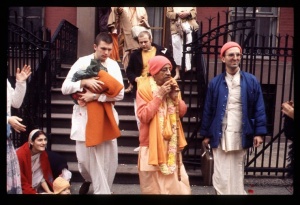CC Madhya 9.64

A.C. Bhaktivedanta Swami Prabhupada
TEXT 64
mahāprabhu cali’ āilā tripati-trimalle
catur-bhuja mūrti dekhi’ vyeṅkaṭādrye cale
SYNONYMS
mahāprabhu—Lord Śrī Caitanya Mahāprabhu; cali’ āilā—arrived by walking; tripati-trimalle—at the holy places named Tirupati and Tirumala; catur-bhuja—four-handed; mūrti—Deity; dekhi’—seeing; vyeṅkaṭa-adrye—to the holy place Veṅkaṭa Hill; cale—began to proceed.
TRANSLATION
Śrī Caitanya Mahāprabhu next arrived at Tirupati and Tirumala, where He saw a four-handed Deity. Then He proceeded toward Veṅkaṭa Hill.
PURPORT
Śrīla Bhaktisiddhānta Sarasvatī Ṭhākura has actually described the chronological order of Lord Caitanya Mahāprabhu’s visit. The Tirupati temple is sometimes called Tirupaṭura. It is situated on the northern side of Arcot in the district of Candragiri. It is a famous holy place of pilgrimage. In pursuance of His name, Veṅkaṭeśvara, the four-handed Lord Viṣṇu, the Deity of Bālājī, with His potencies named Śrī and Bhū, is located on Veṅkaṭa Hill, about eight miles from Tirupati. This Veṅkaṭeśvara Deity is in the form of Lord Viṣṇu, and the place where He is situated is known as Veṅkaṭa-kṣetra. There are many temples in southern India, but this Bālājī temple is especially opulent. A great fair is held there in the month of Āśvina (September-October). There is a railway station called Tirupati on the Southern Railway. Nimna-tirupati is located in the valley of Veṅkaṭa Hill. There are several temples there also, among which are those of Govindarāja and Lord Rāmacandra.